
The United States is often considered one of the least healthy affluent nations, due in part to its low life expectancy, expensive health care, and an ever-increasing adult obesity rate. Life expectancy at birth nationwide is 78.6 years, one of the lowest among OECD nations. Still, health varies significantly nationwide, and in many U.S. cities, Americans are less obese and generally live longer, healthier lives.
There are many factors that contribute to one’s ability to live a long, healthy life, ranging from certain behaviors to financial stability. 24/7 Wall St. reviewed 35 health factors and outcomes from the County Health Rankings and Roadmaps program, a collaboration between the Robert Wood Johnson Foundation and the University of Wisconsin Population Health Institute, to identify the 25 healthiest metropolitan areas in the country.
One of the best ways to measure the health of a population is the premature death rate — the rate at which residents die before the age of 75. In our index, we weighted premature death more heavily than any other measure.
Click here to see the 25 Healthiest Cities in America.
There appears to be a strong correlation between income and health. Among the 25 healthiest U.S. cities, all but six exceed the national median household income of $57,617. Places with a higher median household income typically report better health outcomes, likely because residents are better able to afford health care as well as nutritious foods, gym memberships, and other things that help facilitate a healthy lifestyle.
Having health insurance is another crucial component in maintaining good health as it ensures individuals are receiving proper medical and preventive care. Nationwide, 11.0% of people under the age of 65 are not covered by health insurance. Among the 25 healthiest cities, only one has a higher than average share of residents under 65 without insurance coverage.
Both health insurance and income are important. However, healthy behaviors and habits can also impact health. Certain behavioral factors and indicators, such as smoking and obesity, can increase the risk of a number of chronic diseases and health complications. Nationwide, 17% of adults identify as smokers, and 28% of adults are obese. The vast majority of the healthiest cities are home to a smaller share of adult who are obese or smoke than the country as a whole.
24/7 Wall St. created an index modeled after an analysis conducted by County Health Rankings & Roadmaps, a Robert Wood Johnson Foundation and University of Wisconsin Population Health Institute joint program. To identify the 25 healthiest cities, 24/7 Wall St. reviewed all U.S. metropolitan statistical areas. The index rankings are based on overall health outcomes, a weighted composite of length of life, quality of life, and overall health factors. The health factors component is itself a weighted composite of healthy behaviors, clinical care, social and economic factors, and physical environment measures. Median household income figures and poverty rates came from the Census Bureau’s 2016 American Community Survey. Data on the prevalence of food insecurity in each metropolitan area came from the United States Department of Agriculture 2015 Food Access Research Atlas.

25. Washington-Arlington-Alexandria, DC-VA-MD-WV
> Premature death rate: 252.5 (per 100,000)
> Adult obesity rate: 25.6%
> Pct. under 65 without health insurance: 9.4%
> Median household income: $95,843
The Washington-Arlington-Alexandria metropolitan area is one of the wealthiest in the country with a median household income of $95,843 a year, far greater than the national median of $57,617. Cities with higher incomes usually report better health outcomes, as more affluent people tend to have access to better medical care and healthy food. Wealthier people also do not have to face the unhealthy stress levels associated with poverty. In the D.C. area, only 12.4% of adults are in fair or poor health, much less than the nationwide share of 16.0%.
Some 17.0% of American adults smoke, but only 12.2% of adults in this metropolitan area do, likely contributing to a lower premature death rate in the D.C. area. For every 100,000 metro area residents, about 252 die before age 75, far less than the national rate of 363 premature deaths per 100,000 people.
[in-text-ad]

24. Santa Rosa, CA
> Premature death rate: 243.2 (per 100,000)
> Adult obesity rate: 20.3%
> Pct. under 65 without health insurance: 10.0%
> Median household income: $73,929
Adults in Santa Rosa, California, are among the healthiest in the nation. Leading an active lifestyle can contribute to a long, healthy life, and nearly 85% of adults in this city are physically active — one of the highest shares in the nation. The relatively high share of physically active adults likely explains the low obesity rate of just 20.3%, much less than the national rate of 28.0%. Maintaining a healthy body weight can help people avoid deadly health conditions such as cardiovascular disease and diabetes, and adults in Santa Rosa are less likely to die prematurely than most Americans. For every 100,000 residents some 243 die before the age of 75, far less than the national rate of 363 per 100,000 people.
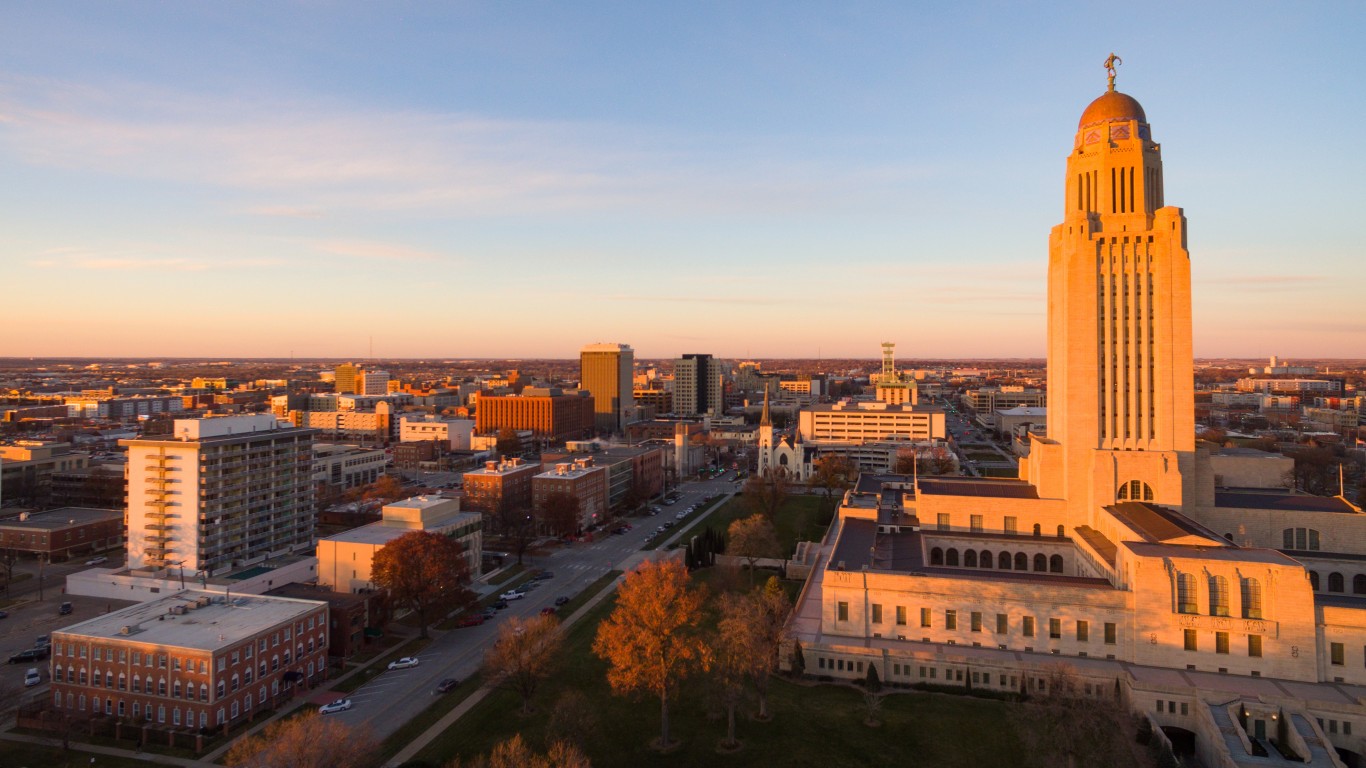
23. Lincoln, NE
> Premature death rate: 274.5 (per 100,000)
> Adult obesity rate: 27.4%
> Pct. under 65 without health insurance: 9.0%
> Median household income: $59,344
Maintaining an active, healthy lifestyle can be dependent on opportunity. In Lincoln, Nebraska, 95.1% of residents have access to places for physical activity such as parks and recreation centers. For perspective, only 83% of Americans have access to such facilities. Adults in Lincoln appear to be taking advantage of these opportunities, with only 18.1% leading sedentary lifestyles, less than the national average of 23.0%.
Engaging in regular physical activity is important for maintaining good health, and only 11.1% of adults in Lincoln report being in fair or poor health, one of the lowest shares in any metropolitan area in America. Additionally, Lincoln adults report some of the fewest days of poor mental and physical health per month in the nation.
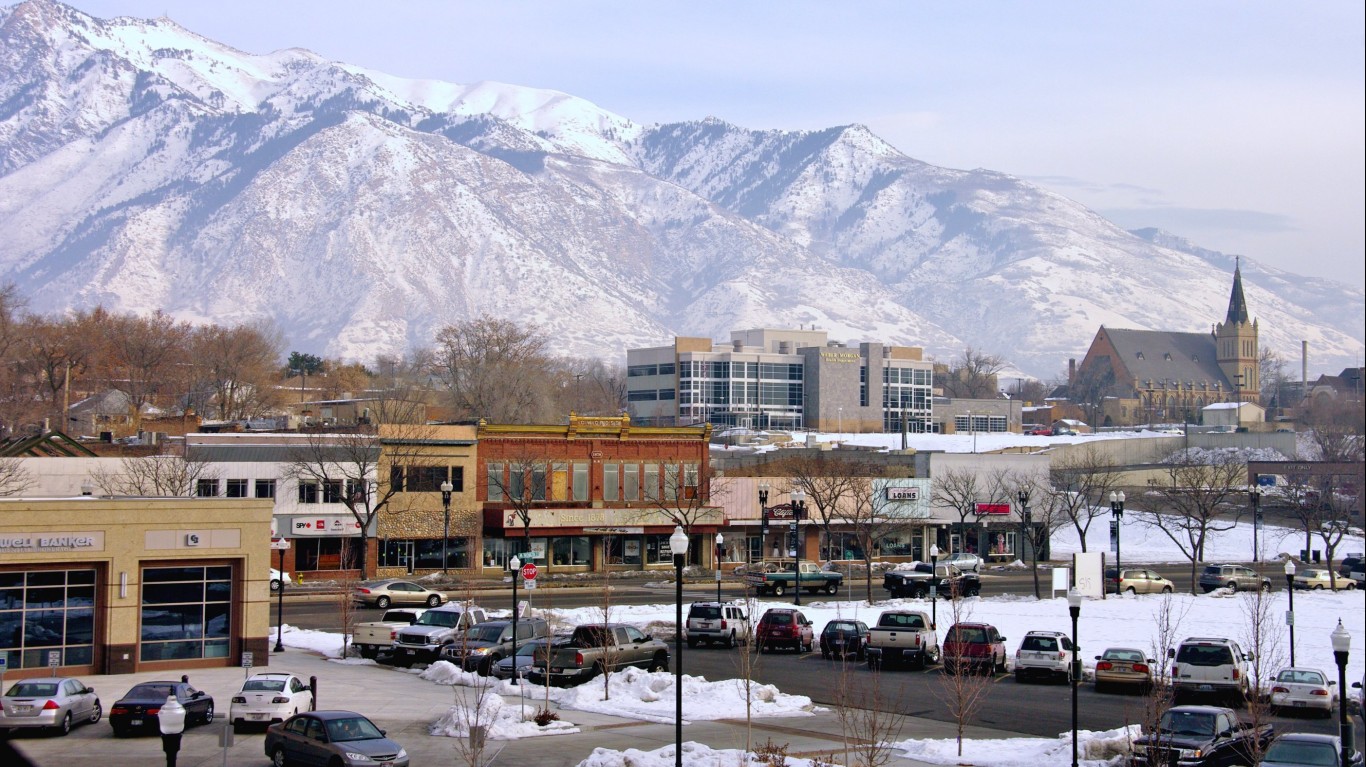
22. Ogden-Clearfield, UT
> Premature death rate: 289.7 (per 100,000)
> Adult obesity rate: 26.6%
> Pct. under 65 without health insurance: 9.5%
> Median household income: $70,227
According to the CDC, smoking is the leading cause of preventable death nationwide. While 17.7% of adults smoke nationwide, only 8.3% do in Odgen-Clearfield.
Other factors that can contribute to a long, healthy life, such as access to health care, nutritious food, and exercising options, can be costly. However, this may be less of an issue for residents of this Utah metro area. The typical household in Odgen-Clearfield earns $70,227 a year, considerably more the national median household income of $57,617. Additionally, only 11.4% of metro area children live in poverty, far less than the national average of 20%. Children who live in poverty are more susceptible to malnutrition and obesity, and are less likely to have access to quality medical care.
[in-text-ad-2]

21. Fargo, ND-MN
> Premature death rate: 291.8 (per 100,000)
> Adult obesity rate: 29.3%
> Pct. under 65 without health insurance: 7.0%
> Median household income: $60,009
People with health insurance are far more likely to go to the doctor regularly and receive preventive care than those who do not have insurance. In Fargo, 93% of residents under the age of 65 have health insurance, one of the best coverage rates in the country. This widespread access to health care is likely contributing to a low premature death rate. Each year, 291 out of every 100,000 residents die before age 75, much less than the national rate of 363 premature deaths per 100,000 Americans.
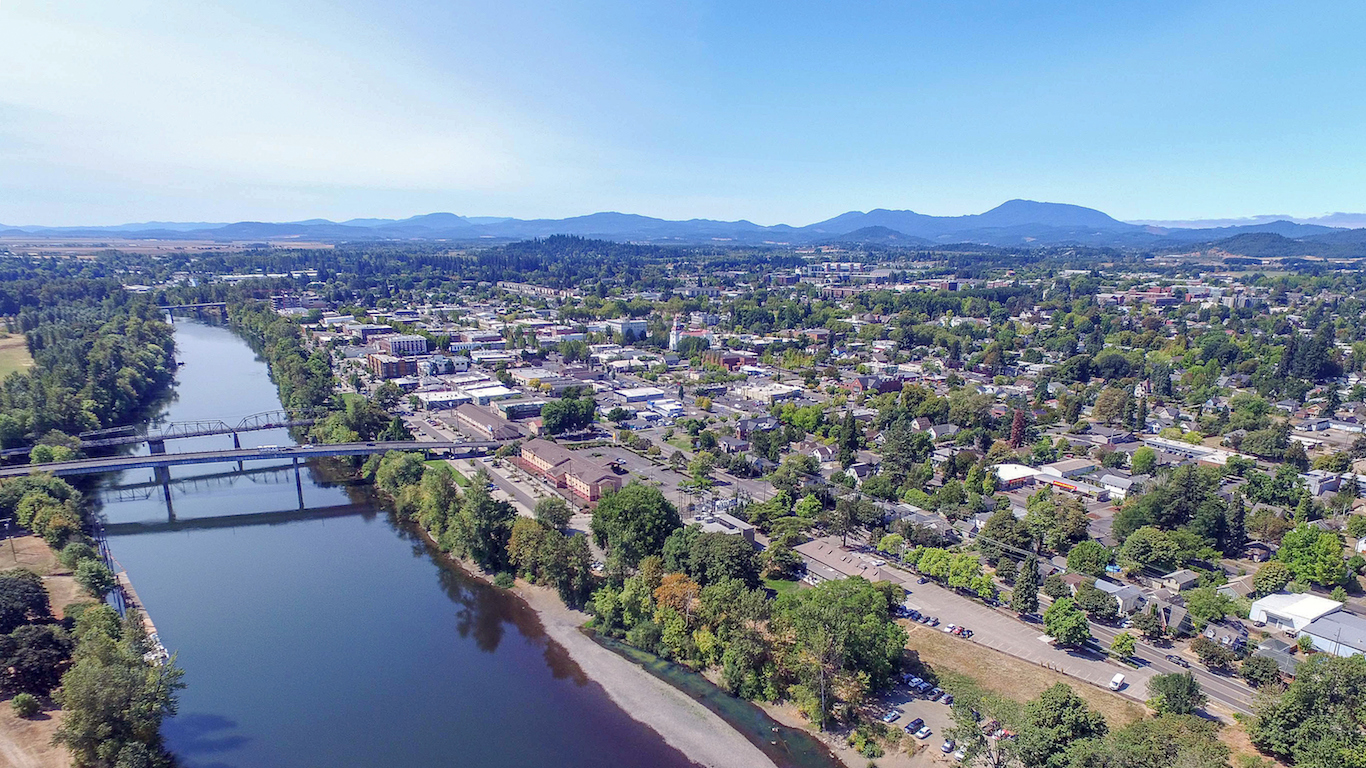
20. Corvallis, OR
> Premature death rate: 228.6 (per 100,000)
> Adult obesity rate: 24.4%
> Pct. under 65 without health insurance: N/A
> Median household income: $55,459
Adults in Corvallis, Oregon, are among of the healthiest in the nation and are less likely to die before age 75 than the average American. Corvallis residents die prematurely — before the age of 75 — at a rate of 228 for every 100,000 metro area residents, considerably less than the 363 premature deaths per 100,000 Americans. Corvallis adults can partially attribute the lower premature death rate to their healthy habits. Nearly 89% of adults in this metro area lead physically active lifestyles, the third highest share in the nation. Additionally, Corvallis’ adult obesity and smoking rates are considerably lower than the comparable national figures.
[in-text-ad]

19. Appleton, WI
> Premature death rate: 268.2 (per 100,000)
> Adult obesity rate: 30.3%
> Pct. under 65 without health insurance: 5.2%
> Median household income: $63,902
Like most of the healthiest cities in the country, only a small share of residents in Appleton, Wisconsin, are not financially secure. Only 7.6% of residents live in poverty, almost half the nationwide poverty rate of 14.0%. Affluent cities tend to have relatively few people who lack access to affordable, nutritious food. In Appleton, only 3.9% of residents are food insecure, one of the lowest shares in the nation.
Exercising regularly can also help lower the risk of chronic health conditions, such as cardiovascular disease, and promote a long, healthy life. Some 90.7% of Appleton residents have access to recreational facilities or parks, and residents clearly take advantage of this opportunity. Just over 80% of adults report they are physically active, more than the 77% of Americans who are active nationwide. Physical activity can lead to good health, and nearly 90% of the area’s adults report they are in good health, one of the highest shares of any metropolitan area.
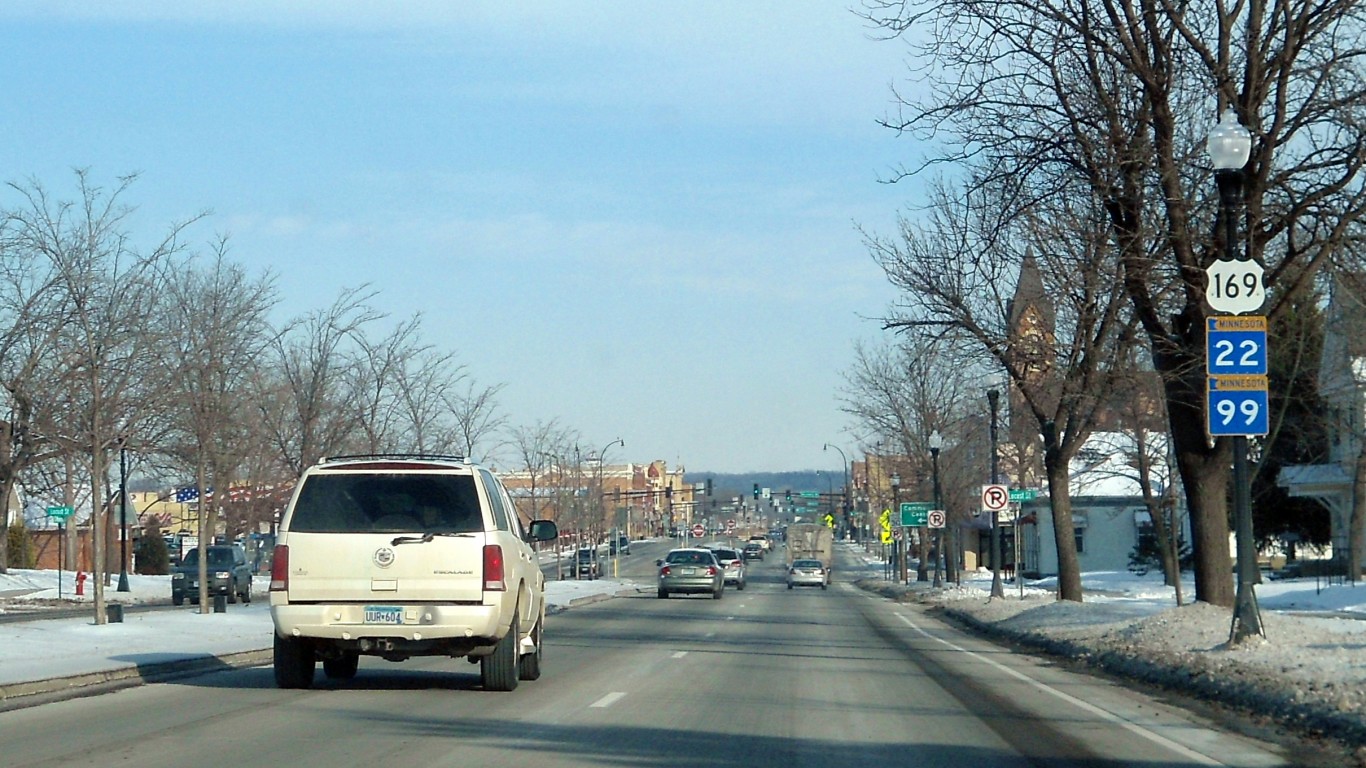
18. Mankato-North Mankato, MN
> Premature death rate: 250.0 (per 100,000)
> Adult obesity rate: 33.3%
> Pct. under 65 without health insurance: N/A
> Median household income: $57,833
Adults in Mankato-North Mankato, Minnesota, are among of the healthiest in the nation. Area residents die prematurely — before the age of 75 — at a rate of 250 for every 100,000 metro area residents, considerably less than the 363 premature deaths per 100,000 Americans. In addition, adults in this area report only an average of 3.1 mentally unhealthy days per month, one of the lowest shares nationwide. Healthy behavior among Mankato adults is likely contributing to the region’s low premature death rate and better mental health. Adults in this Minnesota metro area are more likely to exercise and less likely to smoke.

17. St. George, UT
> Premature death rate: 263.1 (per 100,000)
> Adult obesity rate: 24.3%
> Pct. under 65 without health insurance: 15.4%
> Median household income: $55,056
Only 11.5% of adults in the St. George area report being in fair or poor health, a smaller share than in all but a handful of other U.S. metro areas. The better self-reported health outcomes are likely the result of area residents’ healthy behaviors and lifestyles. Only 24.3% of adults are obese, far less than the national rate of 28.0%. Even more impressive, however, is the metro area’s low smoking rate. Some 7.7% of adults in St. George smoke, the second lowest rate in the nation.
[in-text-ad-2]

16. Urban Honolulu, HI
> Premature death rate: 270.3 (per 100,000)
> Adult obesity rate: 22.2%
> Pct. under 65 without health insurance: 4.4%
> Median household income: $80,513
Employment can be a significant factor in maintaining good health for several reasons. Those with steady employment do not have to stress about earning a regular income, and often have health insurance provided by their place of work. Only 2.2% of the workforce in Urban Honolulu is out of a job, the second lowest unemployment rate of any U.S. metropolitan area. Honolulu’s low unemployment likely contributes to its higher health insurance coverage rate and lower poverty rate. Only 4.4% of the metro area’s population under 65 years is uninsured, and 8.5% live in poverty, well below the corresponding national rates of 11.0% and 14.0%. Those with health insurance coverage tend to have better access to medical and preventive care.

15. Iowa City, IA
> Premature death rate: 250.9 (per 100,000)
> Adult obesity rate: 24.5%
> Pct. under 65 without health insurance: 6.8%
> Median household income: $57,777
A high food insecurity rate in an area suggests that relatively many residents are likely low income and live far away from supermarkets, where fresh produce and other healthy foods are available. While the median annual household income in Iowa City of $57,777 just brushes above the national median of $57,617, only 2.9% of residents are food insecure, one of the lowest rates in the country.
Iowa City residents tend to lead healthier lifestyles than the average American. Adults in this metro area are less likely to be obese and smoke. Additionally, area adults report fewer mentally and physically unhealthy days per month at 3.3 and 2.8, respectively — some of the lowest figures nationwide. Perhaps all of these factors contribute to the metropolitan area’s low premature death rate. Iowa City residents die before the age of 75 at a rate of 250 for every 100,000 people. In contrast, the national rate is 363 premature deaths per every 100,000 people.
[in-text-ad]

14. Madison, WI
> Premature death rate: 244.7 (per 100,000)
> Adult obesity rate: 26.0%
> Pct. under 65 without health insurance: 5.5%
> Median household income: $68,497
Those with health insurance are far more likely to receive necessary medical and preventative care than those without. Nearly 95% of all residents in Madison, Wisconsin have health insurance, among the highest coverage rates nationwide. In addition to widespread medical coverage, area residents are more likely to be physically active in their free time than most Americans. This figure could be influenced by the prevalence of exercise facilities and parks in the area. Some 90% of the population has access to either a park or gym.
Regardless, only 17.1% of adults lead sedentary lifestyles, less than the 23% of Americans who are physically inactive nationwide. Both of these factors likely help explain the low premature death rate in Madison. Residents die prematurely at a rate of 244 per 100,000 people, one of the lowest premature death rates in the nation.

13. St. Cloud, MN
> Premature death rate: 248.5 (per 100,000)
> Adult obesity rate: 28.1%
> Pct. under 65 without health insurance: 5.3%
> Median household income: $56,620
St. Cloud, Minnesota has one of the lowest death rates from intoxicated drivers. Some 20% of motor vehicle deaths in this metropolitan area are tied to alcohol, much lower than the national rate of 29.0%. This lower rate may positively impact the premature death rate in St. Cloud. Area residents are less likely to die before age 75 than residents in most other metropolitan areas in the country.
Area residents also lead relatively healthy lifestyles. Some 79% of adults are physically active, above the national average of 77%, despite only 76% of the population having access to a park or recreational facility — one of the lower shares nationally.

12. Manhattan, KS
> Premature death rate: 251.3 (per 100,000)
> Adult obesity rate: 25.7%
> Pct. under 65 without health insurance: N/A
> Median household income: $52,720
When it comes to purchasing healthful foods, residents in Manhattan, Kansas, are at a noticeable disadvantage. Nearly one in five residents are food insecure, the seventh highest rate in the nation. Despite these disadvantages to leading a healthy lifestyle, residents in this Kansas metropolitan area some of the healthiest in the country. Area adults are more likely to exercise regularly, less likely to obese, and less likely to smoke. They also report on average just 3.3 days of poor mental health and 3.1 days of poor physical health each month, compared to the national averages of 3.8 days of poor mental health and 3.7 days poor physical health.
[in-text-ad-2]

11. State College, PA
> Premature death rate: 216.5 (per 100,000)
> Adult obesity rate: 29.3%
> Pct. under 65 without health insurance: 6.6%
> Median household income: $60,266
Residents in State College are much more likely to live past 75 than residents in other metropolitan areas in the United States. Residents die prematurely at a rate of 216 deaths per 100,000 people, the third lowest premature death rate in the country. Perhaps the lower prevalence of premature deaths in State College is partially the result of the area’s widespread health care coverage. People who are covered by health insurance are much more likely to receive necessary and preventative medical care than those without it. Over 93% of area residents below age 65 have health insurance, exceeding the national coverage rate of just 89%.

10. Fort Collins, CO
> Premature death rate: 244.9 (per 100,000)
> Adult obesity rate: 17.8%
> Pct. under 65 without health insurance: 8.5%
> Median household income: $66,469
Only 10.4% of adults in Fort Collins report they are in fair or poor health, the third lowest share of any metropolitan area. Area adults also report some of the fewest mentally and physically unhealthy days per month at 3.2 and 3.0, respectively — both of which are among the lowest figures nationwide. Adults in Fort Collins are among some of the healthiest in the country likely due to their healthy habits. Nearly 87% of the adults are physically active, the fourth highest share of any metropolitan area. The adult obesity rate of just 17.8% is the third lowest share in the country. Additionally, only 12.6% of area adults smoke, in contrast to the 17.0% of American adults who smoke nationwide.
[in-text-ad]

9. Bridgeport-Stamford-Norwalk, CT
> Premature death rate: 219.1 (per 100,000)
> Adult obesity rate: 21.4%
> Pct. under 65 without health insurance: 9.9%
> Median household income: $90,123
Financial stability is a contributing factor to good health. People who earn higher incomes are less likely to struggle to afford healthy food or medical treatment. Residents in the Bridgeport-Stamford-Norwalk metropolitan area are some of the wealthiest in the nation. The area’s median household income of $90,123 a year greatly exceeds the national median of $57,617 and is the fourth highest median income in the country. Due in part to higher incomes, only 3.2% of residents struggle to afford food, one of the smallest food insecurity rates of any city in the country.
Further contributing to good overall health is the low smoking rate in Bridgeport. Some 10.4% of area adults smoke, among the 10 lowest rates in the nation.
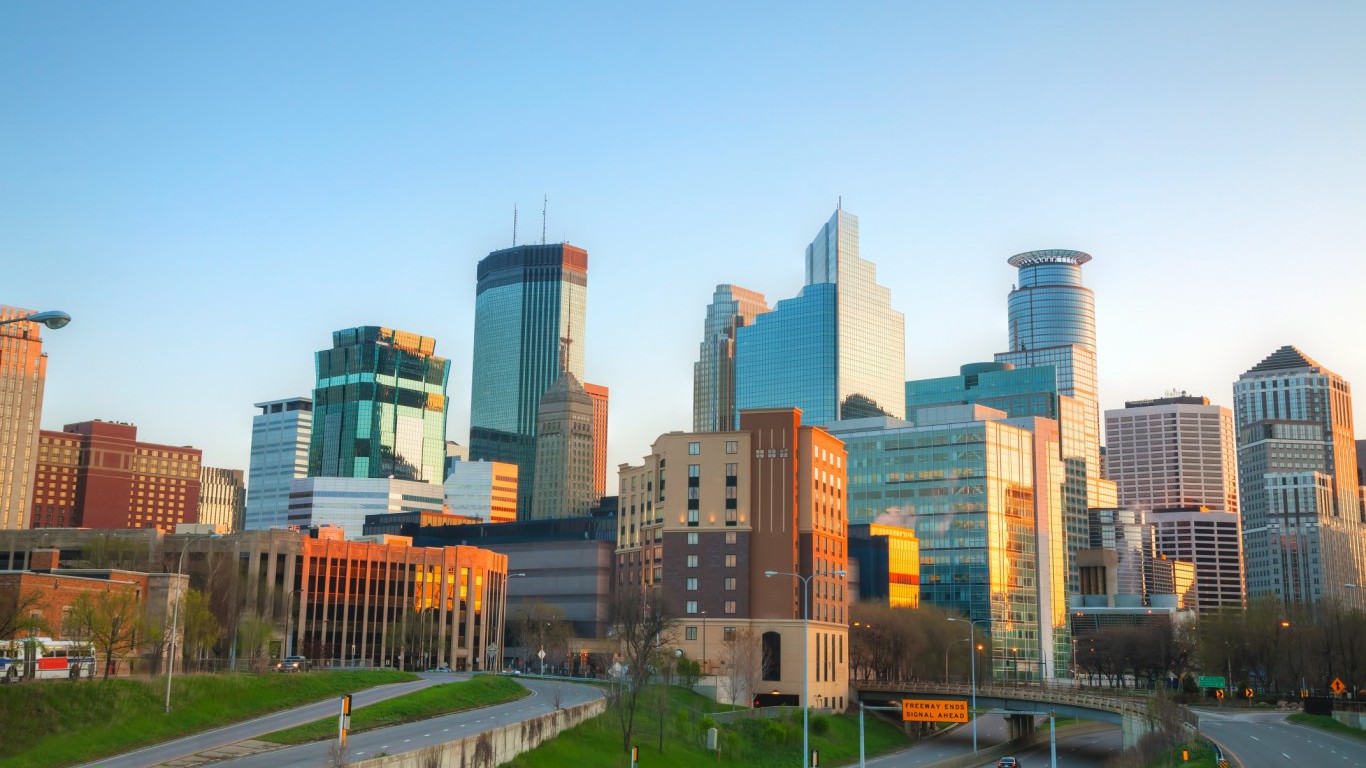
8. Minneapolis-St. Paul-Bloomington, MN-WI
> Premature death rate: 250.1 (per 100,000)
> Adult obesity rate: 25.7%
> Pct. under 65 without health insurance: 5.9%
> Median household income: $73,231
Those with health insurance are far more likely to go to the doctor for regular checkups and receive necessary and preventative medical care than those who do not have coverage. Some 94% of residents under the age of 65 have health insurance in the Minneapolis-St. Paul-Bloomington metropolitan area, among the highest shares nationwide. Area residents also appear to lead healthy lifestyles and report below average smoking and obesity rates. Metro area residents are among the least likely to feel unhealthy at any given time. Area residents report just 3.0 days of poor mental health and 2.7 days of poor physical health per month, compared to the national average of 3.8 poor mental health days and 3.7 poor physical health days.

7. San Francisco-Oakland-Hayward, CA
> Premature death rate: 226.6 (per 100,000)
> Adult obesity rate: 19.9%
> Pct. under 65 without health insurance: 7.7%
> Median household income: $96,677
Earning a sufficient income can help most Americans avoid food insecurity, which can ultimately enable one to live a healthier and perhaps even longer life. Affording healthy foods does not appear to be an issue for residents in the San Francisco-oakland-Hayward metropolitan area. The median household income in this area is $96,677, the second highest in the nation. With this area being so affluent, it is not a coincidence that only 1.5% of area residents are food insecure, the fifth lowest share of any other metropolitan area.
Additionally, only 19.9% adults in this area are obese, much less than the national rate of 28.0%. The low prevalence of obesity likely contributes to the area’s low premature death rate. Residents die prematurely at the rate of 226 per 100,000 people, the sixth lowest share among the nation.
[in-text-ad-2]

6. Ames, IA
> Premature death rate: 241.8 (per 100,000)
> Adult obesity rate: 27.0%
> Pct. under 65 without health insurance: N/A
> Median household income: $53,371
Being gainfully employed helps in maintaining good health. For one, most Americans are insured through their work. Another factor might be lower stress that comes with a regular income. Only 2.0% of the workforce in Ames, Iowa, does not have a steady job, the lowest unemployment rate of any metropolitan area in the country. Ames adults also lead relatively healthy lifestyles. They are less likely to be obese, physically inactive, and to smoke. All of these factors likely contribute to the area’s low premature death rate — residents die before the age of 75 at a rate of 241 deaths per 100,000 Ames residents, one of the lowest premature death rates in the nation.

5. Rochester, MN
> Premature death rate: 227.1 (per 100,000)
> Adult obesity rate: 27.3%
> Pct. under 65 without health insurance: 5.6%
> Median household income: $70,078
According to the American Diabetes Association, 30.3 million Americans have diabetes, or 9.4% of the American population. Properly managing the disease is essential to keeping it in check, and Rochester’s diabetes patients are among the best at monitoring the condition. Some 94.0% of diabetes patients in Rochester receive the HbA1c test, a blood test that monitors blood glucose levels and indicates how well one’s diabetes is being controlled. That is the highest share of any other metropolitan area in the country.
Rochester residents also get to choose from a widespread selection of primary care doctors. There are 175 doctors per every 100,000 residents in Rochester, the highest concentration of doctors in the nation. Almost 90% of the area’s adults report being in good health, compared to the national share of 84% of adults who report the same.
[in-text-ad]

4. Boulder, CO
> Premature death rate: 212.0 (per 100,000)
> Adult obesity rate: 13.8%
> Pct. under 65 without health insurance: 7.4%
> Median household income: $74,615
Several factors contribute to Boulder’s rank as the fourth healthiest city. Nearly 97% of Boulder adults have access to places for physical activity such as a parks or recreational facilities. In contrast, only 83% of Americans nationwide have access to such places. Adults in Boulder are among the healthiest in the nation, partially due to their healthy habits. For example, 90% of adults in Boulder are physically active, the highest share among any U.S. metropolitan area. The high activity rate likely greatly contributes to the low adult obesity rate. Just 13.8% of area adults are obese, the second lowest rate in the nation.
Exercising regularly and keeping excess weight off can lower the risk of chronic diseases and ultimately lengthen one’s life. Boulder residents are much more likely to live past the age of 75 than all but just one other metropolitan area.

3. Provo-Orem, UT
> Premature death rate: 257.0 (per 100,000)
> Adult obesity rate: 24.7%
> Pct. under 65 without health insurance: 10.3%
> Median household income: $69,288
Provo-Orem is the third healthiest metropolitan area in the country. Area residents report good health outcomes, such as a below average adult obesity rate. Area adults are also more likely to exercise — over 84% are physically active, more than the 77% of American adults who exercise nationwide. A strong majority of Provo-Orem adults also avoid unhealthy behaviors, specifically smoking and drinking excessively. In the United States, some 17.0% of Americans smoke and 18.0% drink excessively. In this Utah metropolitan area, however, only 6.8% of adults smoke, and only 9.9% drink to excess, both of which the lowest shares in the country.
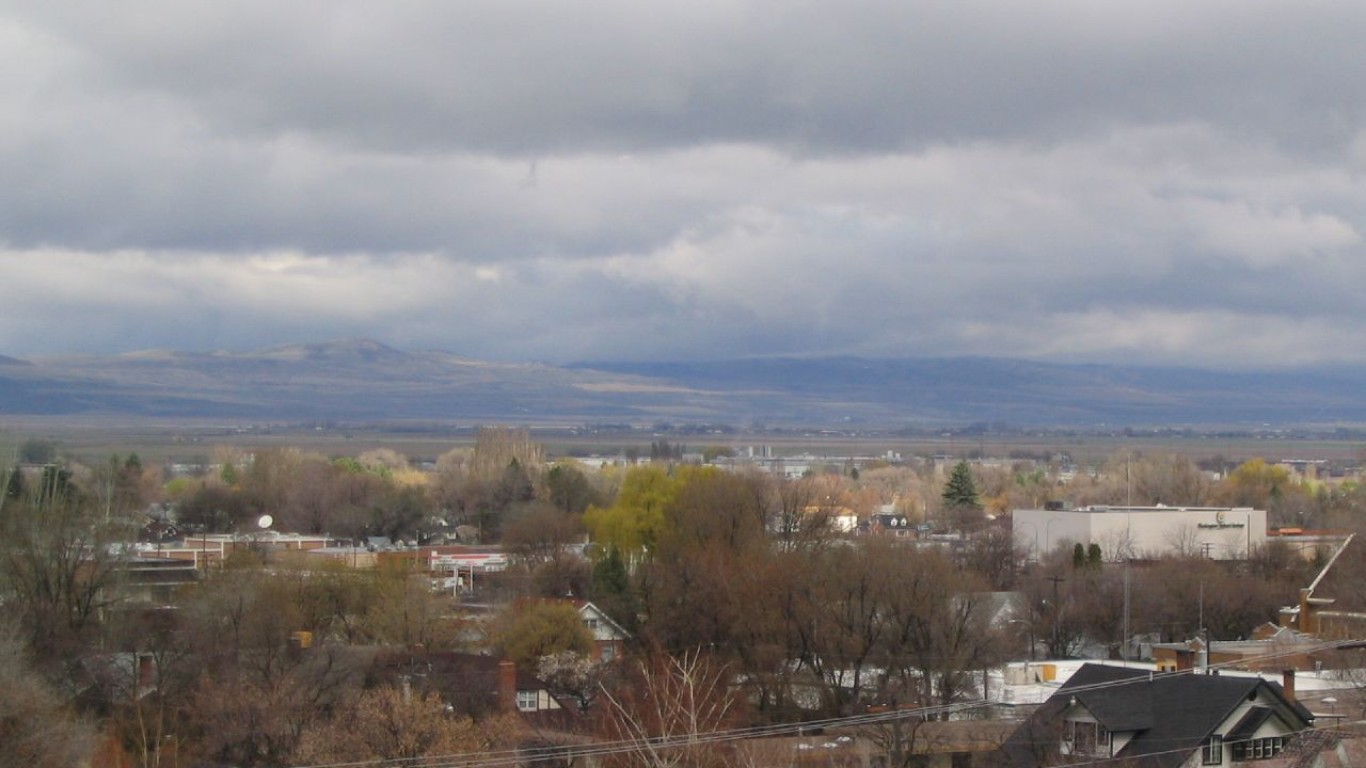
2. Logan, UT-ID
> Premature death rate: 233.4 (per 100,000)
> Adult obesity rate: 24.5%
> Pct. under 65 without health insurance: 9.8%
> Median household income: $57,414
Employment can be important for personal health as it often provides health insurance and removes the stress of not having a consistent income. In Logan, only 2.7% of the workforce is out of a job, much less than the national unemployment rate of 4.4%. Additionally, only 10.8% of area adults report they are in fair or poor health, one of the lowest shares of any metropolitan area. A key contributor in maintaining good health is to avoid smoking, and in Logan only 8.6% of adults smoke, far less than the national rate of 17.0% and the fifth lowest share nationwide.
[in-text-ad-2]

1. San Jose-Sunnyvale-Santa Clara, CA
> Premature death rate: 196.3 (per 100,000)
> Adult obesity rate: 19.8%
> Pct. under 65 without health insurance: 7.6%
> Median household income: $110,040
San Jose-Sunnyvale-Santa Clara is the healthiest metropolitan area in the country. Area residents can partially attribute their good health to financial stability. The median household income in this metro area is $110,040 a year, the highest of any U.S. metropolitan area. Earning an ample income makes it considerably easier to afford health care and nutritious foods, and high income residents do not have to face the unhealthy stress levels associated with poverty.
Adults in this affluent California metropolitan area also report one of the lowest obesity rates in the country, at just 19.8%. In contrast, the national obesity rate is 28.0%. Area adults are also much less likely to smoke and more likely to exercise than those in most metropolitan areas. They also report fewer mentally and physically unhealthy days per month than the national average. All of these healthy habits have likely contributed to the area’s low premature death rate. Residents die before the age of 75 at a rate of 196 deaths per 100,000 people — the lowest rate nationwide.
Are You Ahead, or Behind on Retirement?
If you’re one of the over 4 Million Americans set to retire this year, you may want to pay attention. Many people have worked their whole lives preparing to retire without ever knowing the answer to the most important question: am I ahead, or behind on my goals?
Don’t make the same mistake. It’s an easy question to answer. A quick conversation with a financial advisor can help you unpack your savings, spending, and goals for your money. With Zoe Financial’s free matching tool, you can connect with trusted financial advisors in minutes.
Why wait? Click here to get started today!
Thank you for reading! Have some feedback for us?
Contact the 24/7 Wall St. editorial team.




